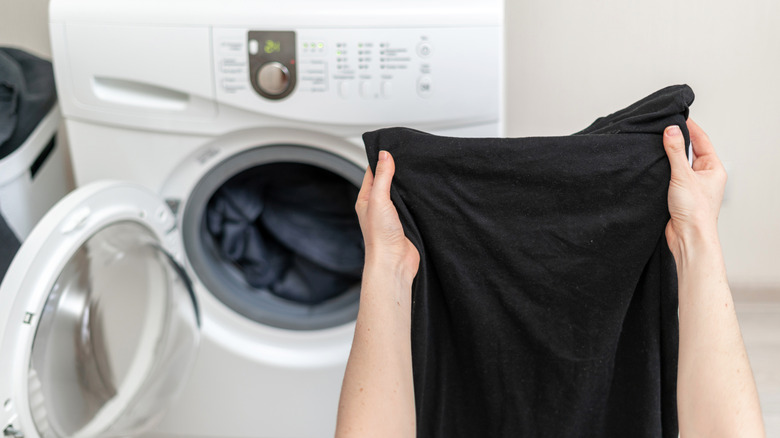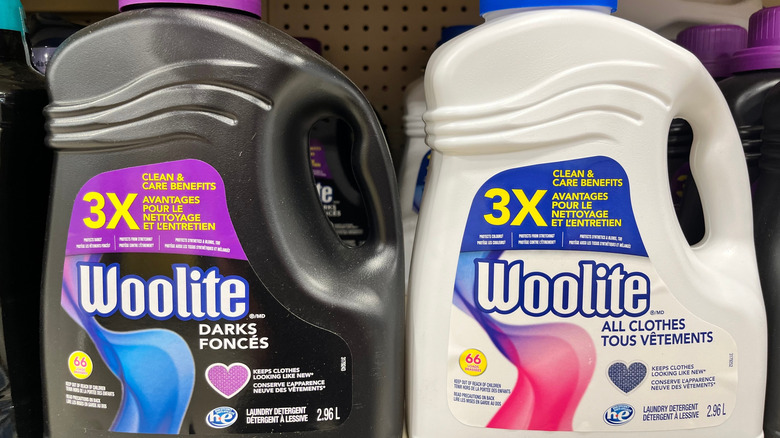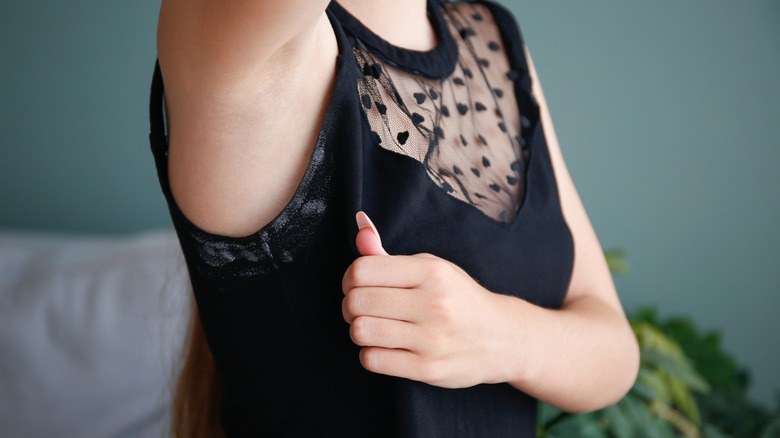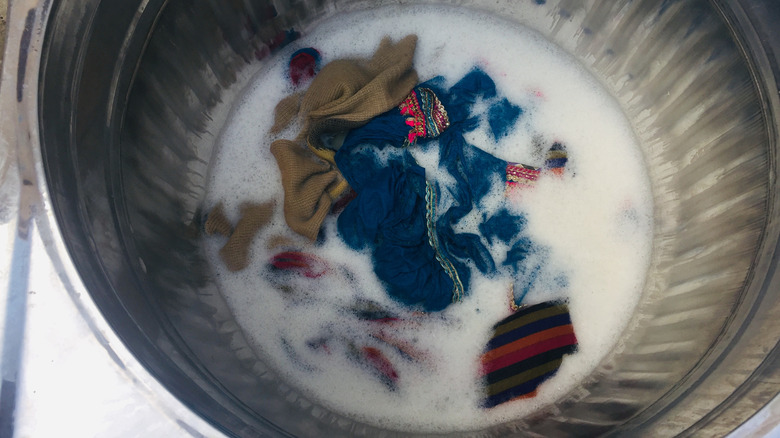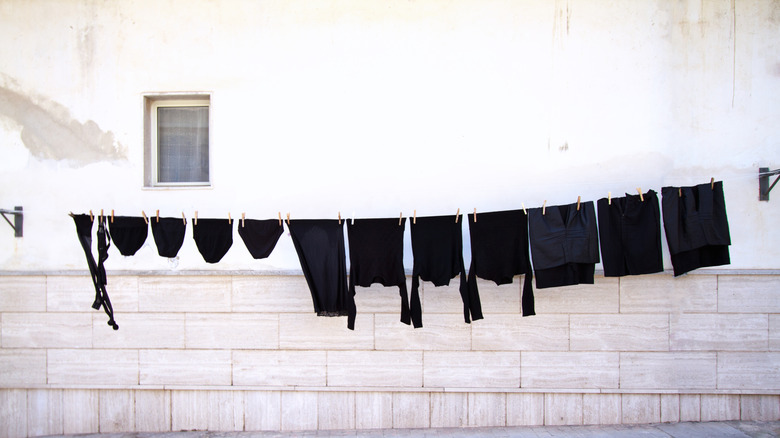The Best Way To Wash Black Clothing So The Color Doesn't Fade
We may receive a commission on purchases made from links.
Nothing says timeless, chic, or even grunge quite like black. It goes with anything, can be dressed up or down, and is a staple in almost everyone's closet. It does have one problem, though. Black clothing tends to fade after several washes. This can be due to a few things. Sometimes the dye in the clothing will bleed and dull the color. Washing in hot water and using harsh laundry detergent can also cause fading, and the friction caused by the washing machine's agitator can add to the dye loss. If this happens often enough, it may be destined for the pile of repurposed old clothing for your home and garden. But with a combination of detergents free from harsh chemicals, washing on a cold cycle, and reducing the amount of times you wash them, you can prevent the color from fading and help keep black clothes looking great for a long time to come.
That said, the best defense against fading black clothes starts at the store. The garments most likely to fade are usually made with a lower quality fabric or dye. When shopping for black clothing, look for care labels that use phrases signaling color bleeding like "Color Rubs Off" or "Wash Before Wear." Check the fabric type, as well. Synthetic fibers like polyester are more colorfast than natural fibers, like cotton. Regardless of fabric, it's a good idea to wash your black clothing by itself the first time you launder, just to be safe.
Use the right laundry detergent
Check the care label for the best laundering method, as this will be your best source for properly caring for your item. Delicate materials like silk, wool, or anything embroidered can be damaged by washing in a regular cycle. Washing according to the manufacturer's instructions will prolong the life of your garment. Also, try one of these clever laundry tips and tricks HGTV stars swear by. Sort black clothing from other colors and fabrics and wash alike colors and fabrics together.
The right laundry detergent also matters. Some laundry detergents have harsh chemicals that can cause the fabric to fade. Make sure to choose a detergent that does not have bleach, brighteners, or enzymes. Better yet, choose a detergent that is made for dark clothes. Perwoll's Liquid Detergent formula can actually renew color, while Woolite's Dark Defense can slow the fading process (available at most grocery stores). Be careful not to use too much, though. It may be helpful to use a little less than you think you need. Too much laundry detergent tends to stay in the clothing and can actually cause the fabric to hold on to some of the dirt. We ranked popular laundry detergents from worst to best based on reviews to help you choose your best clean.
Proper washing technique
A liquid detergent is less likely to leave residue on your clothing than powdered detergent. Add the liquid detergent to the washing machine's drum before adding your clothes to help evenly distribute the detergent. Be careful not to add too much or it will cause a build up of residue in your clothes. Turn the garments inside out to help prevent dye loss. This also helps reduce wear and tear on the fabric by minimizing contact between the outer fabric and the washing machine drum and agitator. Also, wash in a cold water cycle. Warm water causes the clothing fibers to open and release dye. Cold water doesn't. Washing in cold water not only saves your clothes — it prevents the black dye from bleeding onto lighter colored clothing.
Skip the fabric softener, as well. It can leave a residue on fabric, making it appear dull. Fabric softeners are made with emulsifiers, which creates a lubricating layer on the fabric's fibers. It's what makes your clothing feel so soft and smell so good, but they're not a requirement in laundry care. You can ditch the fabric softener and try these alternatives instead.
Reduce washing frequency
Friction can be rough on clothing of any color. It's caused by everyday movement like walking, sitting, or carrying groceries. It's also created in the washing machine as clothes rub against each other. This friction causes fibers in the clothes to weaken and pill or fade. Rotating how often you wear your black garments will help reduce the number of times you need to wash them, and that will help them stay in great shape longer.
Cutting back on how often you wash your black garments may help, too. Laundering your clothes is important — make no mistake. Wearing dirty laundry can breed microorganisms, which can lead to skin infections, and let's face it, it's just gross. The closer a garment is worn to the body, the more frequently it should be washed. However, if the black blouse you wore for a couple of hours at last night's party didn't get soiled, you can probably clean it using another method. A surprising hack is using vodka to clean your clothing by spritzing the garment with a pure version of the spirit.
Dry and store black clothing properly
Hands down the best method for drying black clothing is by air drying. It's super gentle and there's no friction to dull the color. However, choose a shady spot outside or hang them on a drying rack indoors. Too much sun exposure can bleach the color and cause it to fade. Use this IKEA hack to make the ultimate drying rack for your laundry room, especially if space is tight. If air drying is just not an option, you can dry them in the dryer. However, be sure to use the lowest setting. High temperatures can cause fading. A third option is to dry them in the dryer, and remove them while the clothes are a little damp. Hang to air dry the rest of the way.
Store your freshly laundered clothing items in a cool, dry place to preserve their color. Again, too much sunlight can cause fabrics to fade, so a dark storage area such as a drawer or closet will help maintain the color. Ensuring clothing is stored in a temperature-controlled environment will also protect them from heat damage. If it's time to put clothing away for the season, consider one of these 9 clever ways to use bookshelves to create extra closet storage. This could help avoid the need to store clothing in an attic, basement, or garage, where temperatures might rise higher or lower than the home's interior.
